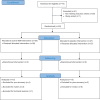Neural changes with attention bias modification for anxiety: a randomized trial
- PMID: 25344944
- PMCID: PMC4483563
- DOI: 10.1093/scan/nsu141
Neural changes with attention bias modification for anxiety: a randomized trial
Abstract
Attention bias modification (ABM) procedures typically reduce anxiety symptoms, yet little is known about the neural changes associated with this behavioral treatment. Healthy adults with high social anxiety symptoms (n = 53) were randomized to receive either active or placebo ABM. Unlike placebo ABM, active ABM aimed to train individuals' attention away from threat. Using the dot-probe task, threat-related attention bias was measured during magnetic resonance imaging before and after acute and extended training over 4 weeks. A subset of participants completed all procedures (n = 30, 15 per group). Group differences in neural activation were identified using standard analyses. Linear regression tested predictive factors of symptom reduction (i.e., training group, baseline indices of threat bias). The active and placebo groups exhibited different patterns of right and left amygdala activation with training. Across all participants irrespective of group, individuals with greater left amygdala activation in the threat-bias contrast prior to training exhibited greater symptom reduction. After accounting for baseline amygdala activation, greater symptom reduction was associated with assignment to the active training group. Greater left amygdala activation at baseline predicted reductions in social anxiety symptoms following ABM. Further research is needed to clarify brain-behavior mechanisms associated with ABM training.
Trial registration: ClinicalTrials.gov NCT00018057.
Keywords: amygdala; anxiety; attention training; dot-probe; fMRI; treatment.
Published by Oxford University Press 2014. This work is written by US Government employees and is in the public domain in the US.
Figures



Similar articles
-
Biobehavioral Markers of Attention Bias Modification in Temperamental Risk for Anxiety: A Randomized Control Trial.J Am Acad Child Adolesc Psychiatry. 2018 Feb;57(2):103-110. doi: 10.1016/j.jaac.2017.11.016. Epub 2017 Nov 28. J Am Acad Child Adolesc Psychiatry. 2018. PMID: 29413142 Free PMC article. Clinical Trial.
-
Protracted amygdalar response predicts efficacy of a computer-based intervention targeting attentional patterns in transdiagnostic clinical anxiety.Transl Psychiatry. 2019 Mar 28;9(1):121. doi: 10.1038/s41398-019-0458-x. Transl Psychiatry. 2019. PMID: 30923309 Free PMC article. Clinical Trial.
-
Training-associated changes and stability of attention bias in youth: Implications for Attention Bias Modification Treatment for pediatric anxiety.Dev Cogn Neurosci. 2013 Apr;4:52-64. doi: 10.1016/j.dcn.2012.11.001. Epub 2012 Nov 10. Dev Cogn Neurosci. 2013. PMID: 23200784 Free PMC article. Clinical Trial.
-
Efficacy of attention bias modification using threat and appetitive stimuli: a meta-analytic review.Behav Ther. 2012 Dec;43(4):724-40. doi: 10.1016/j.beth.2012.01.002. Epub 2012 Jan 18. Behav Ther. 2012. PMID: 23046776 Free PMC article. Review.
-
Research review: Attention bias modification (ABM): a novel treatment for anxiety disorders.J Child Psychol Psychiatry. 2010 Aug;51(8):859-70. doi: 10.1111/j.1469-7610.2010.02251.x. Epub 2010 May 6. J Child Psychol Psychiatry. 2010. PMID: 20456540 Review.
Cited by
-
Effect of facial emotion recognition learning transfers across emotions.Front Psychol. 2024 Jan 19;15:1310101. doi: 10.3389/fpsyg.2024.1310101. eCollection 2024. Front Psychol. 2024. PMID: 38312392 Free PMC article.
-
Biobehavioral Markers of Attention Bias Modification in Temperamental Risk for Anxiety: A Randomized Control Trial.J Am Acad Child Adolesc Psychiatry. 2018 Feb;57(2):103-110. doi: 10.1016/j.jaac.2017.11.016. Epub 2017 Nov 28. J Am Acad Child Adolesc Psychiatry. 2018. PMID: 29413142 Free PMC article. Clinical Trial.
-
Case Series of Transcranial Direct Current Stimulation as an Augmentation Strategy for Attention Bias Modification Treatment in Adolescents with Anxiety Disorders.Klin Spec Psihol. 2020;9(3):105-126. doi: 10.17759/cpse.2020090308. Klin Spec Psihol. 2020. PMID: 39555233 Free PMC article.
-
The neurobiology of dispositional negativity and attentional biases to threat: Implications for understanding anxiety disorders in adults and youth.J Exp Psychopathol. 2016;7(3):311-342. doi: 10.5127/jep.054015. J Exp Psychopathol. 2016. PMID: 27917284 Free PMC article.
-
Novel mechanism-based treatments for pediatric anxiety and depressive disorders.Neuropsychopharmacology. 2024 Jan;49(1):262-275. doi: 10.1038/s41386-023-01709-x. Epub 2023 Aug 22. Neuropsychopharmacology. 2024. PMID: 37608220 Free PMC article. Review.
References
-
- Bar-Haim Y. Research review: attention bias modification (ABM): a novel treatment for anxiety disorders. Journal of Child Psychology and Psychiatry. 2010;51:859–70. - PubMed
-
- Bar-Haim Y, Lamy D, Pergamin L, Bakermans-Kranenburg MJ, van IMH. Threat-related attentional bias in anxious and nonanxious individuals: a meta-analytic study. Psychological Bulletin. 2007;133:1–24. - PubMed
Publication types
MeSH terms
Associated data
Grants and funding
LinkOut - more resources
Full Text Sources
Other Literature Sources
Medical

